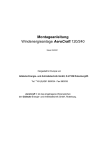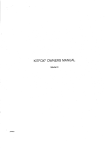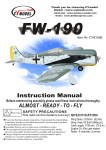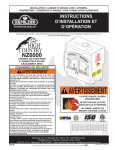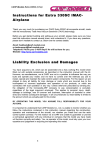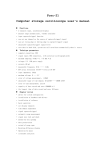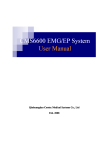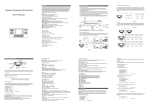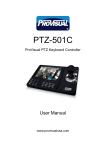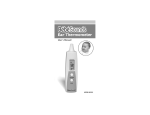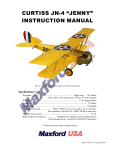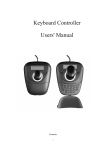Download Installation Manual of Passer / Passer-X Glider
Transcript
Installation Manual of Passer / Passer-X Glider Passer & Passer-X both are advanced Glider. This installation manual is for reference only. Players could install and modify the fuselage and wings by themselves in order to get the most expected flying performance. Items required: Fuselage length: 1010mm Wingspan: 1800mm Wing area: 27.8dm Plane weight: 380g -4Ch or above radio Transmitter x1 -4Ch or above receiver x1 -Micro servo x3 -*400 size motor x1 or Brushless motor x1 -*Fold propeller x1 -*Speed Controller x1 -Battery -Charger Over weight: 650-800g *For Passer-X only Wing load: 23-28g/dm Aerofoil: S4083 Required Tools: Cutting Knives, Cutting Pliers, Model Graver, Pasting Glues Step 1: Install the motor (*for Passer-X only) Paste the wooden motor mount on the front of fuselage as the Photo by using mixing glue. The motor can install it by using 2 pcs of screws after the motor mount is fixed. *If the weight of upgraded motor is higher, a little front parts of fuselage could be cut in order to tuning the C.G. *Brushed motor version *Brushless motor version Step 2: Install the servo mount After installed the motor, the servo mount can be installed in the fuselage as the provided by using glue. *Keep enough space for installing the battery Step3: Install the rear wing. Join the two side of tail wing together with two white small woods by using Glue. *The cover of join must be removed by cutter Step 4: Install the elevator servo rod. Make a push rod into Y type. Make two holes below the installed tail wing as the above photos. Install the servo horns on two side of tail wings. Then connect the servo push rod to the servo horns. Step 5: Connect the servo rod into servo. Paste the blue parts of push rod inside the fuselage by using Glue. Install the servo on the servo mount. Connect the rod into the servo arm by using clevise. *Remarks: Position of the servo could be adjusted in order to match the expected C.G. and the space inside of fuselage. Step 6: Create a hole in order to realease the heat power. (for Passer-X only) Step 7: Install Main Wing Fix two sides of main wings as the above photos. Cut the cover film on two holes. Make a hole on the fuselage as the below photo. Paste the wooden pieces inside the Fuselage. Install 2 nylon screws on the main wing in order to fix on the fuselage. Step 8: Install the aileron servos. Cut 2 pieces of white servo cover as the above photo. Cut the film cover on the bottom of the main wings in order to make two aileron servo seats. Paste the aileron servos in the servo covers. Connect the servo by using extension servo wires. Another size of extension servo wires passes through the hole of main wing as the below photo. The aileron is connected to aileron servos by using servo rod as the below photo. Cover a transparent paste paper on the middle of main wing. *C.G. of the airplane is 66mm behind the front edge of the main wing. This version is for Passer-X Brushed Version Y Cable Ch 3 (ESC) Extension cable Battery Receiver Ch 2 Brushed Motor Ch 1 Remark: Ch1 is connected to 2 Servo and Y Cable Ch2 is connected to 1 Servo and Extension Wire Ch3 is connected to Speed Controller*Passer Version connecting the receiver without using ESC(using Li-poly 7.4v 12c 450mAh) Ch4 is connected to 1 Servo and Extension Wire *T Plug Ch 3 (ESC) Ch 1 Battery Brushless Version Y Cable Ch 2 *This is the version of Passer without ESC *G Plug Receiver Brushless Motor Aileron Elevator Throttle Rudder Channel 1: Aileron Action Control the right-and-left lean of the aircraft. To level the slantwise aircraft, you must make the control rod act in reverse direction. Otherwise, it will make the aircraft overturn. Channel 2: Elevator Action Control the aerocraft to descend or ascend. Pulling the control rod down will drive up the head, and the aeroplane will ascend. Boosting it up will make the head downhill, and the aeroplane will descend. Channel 3: Throttle Operation Control the power. Pulling the control rod down will minish down the power group, and boosting the control rod up will increase the power group. Channel 4: Rudder Action Control the swerve of the aerocraft. Turning the control rod to left will make the head of the aircraft turn left, and turning it to right will make the head turn right. Channel 5: Landing Gear/Gyro Action This channel is for switch variable. It is a switch to control landing gear when used for airplane state, but it will be a switch for gyroscope when used for helicopter. Channel 6: Screw-pitch/Flaperon Action The angle adjusting of the flaperon is for the airplane state, and the adjusting of the main screw-pitch is for helicopter state. A - Function Introduction (6 channels) This item has functions of both airplane and helicopter, and emphasizes more on airplane. The main functions are as follows: (1) At airplane state, channel 1, 2, 4, 6 is a switch for dual rate (D/R) variable: from ± 100% to ± 125%. (2) At airplane state, channel 1 & 6 mixture function: Flaperon. (3) At airplane state, channel 4 & 2 mixture function: V-tail. (4) At airplane state, channel 1 & 2 mixture function: Triangle wing (ELEVON). (5) At airplane state, channel 3 mixture function is to channel 4 & channel 6. (6) At airplane state, channel 3 mixture function is only to channel 6. (7) Channel 1, 2, 3, 4, 6 reverse switch. (8) Normal mode can be used in car model and boat model. (9) Sound-and-light hint notification for low power: when the battery voltage is below 8.8V, the power indicator light 1S/1S glitters and buzzes. And when it is below 8.3V, the power indicator light 0.5S/1S glitters and buzzes at the same time. Switch Function Instruction (A) At helicopter state, pulling A down to put off mixture function of channel 3 to channel 4, when pulling it up it will comeback the function. But the mixture function to channel 6 is stable, which is irrelevant with this switch. (B) Pulling B down is airplane state and pulling it up is helicopter state. (C) At airplane state, pulling 1, 2, 4, 6 down the dual rate is ± 100% ; when pulling them up , the dual rate will be ± 125%. (D) At airplane state, pulling D down make switches have no mixture function, but pulling it up will cause them have the function. (E) At airplane state, when D is pulled up, pulling E down cause channel 1 & 6 mixture function (Flaperon); pulling E up will cause channel 2 & 4 mixture function (V-TAIL). (F) At airplane state, when D is pulled up, pulling F up it works as the mixture function of channel 1 & 2 (Triangle wing ELEVON), and D function doesn’t work at that moment. (G) Channel 1 is reverse switch for aileron. Pulling G down is to make it in normal mode, and pulling it up is to make it act in reverse. (H) Channel 2 is reverse switch for elevator. Pulling H down is to make it in normal mode, and pulling it up is to make it act in reverse. (I) Channel 3 is reverse switch for power. Pulling I down is to make it in normal mode, and pulling it up is to make it act in reverse. (J) Channel 4 is reverse switch for rudder, pulling J down is to make it in normal mode, and pulling it up is to make it act in reverse. (K) Channel 6 is reverse switch for screw-pitch/flaperon. Pulling K down is to make it in normal mode, and pulling it up is to make it act in reverse. Operation of Transmitter Functions of Control Rods MODEL 1 MODEL 2 (Channel 2:Elevator) (Channel 1:Aileron) (Elevator TRIM) (Aileron TRIM) (Channel 4:Elevator) (Channel 3:Power) (Rudder TRIM) (Power TRIM) (Channel 3:Throttle) (Power TRIM) (Channel 4:Rudder) (Rudder TRIM) OPERATION AND ADJUSTMENT About Lithium Polymer Battery Using Lithium Polymer battery to fly your lovely helicopter is your best choice. The Li-Po battery will improve flight performance and flight time, at similar or even less weight than Ni-Mh battery. Anyhow, with 3-cell 11.1V 1400mAh Li-Po battery, your helicopter will do the best aerobatic performance. But one thing that Li-Po batteries are significantly more volatile than the alkaline, Ni-Cd or Ni-Mh batteries used in RC applications. So you should be careful when you use Li-Po battery. Note: When charging Li-Po batteries (3-Cell, 11.1V), charging current should never exceed 0.5A and charging voltage should never exceed 12.6V, and when you charge your Li-Po battery, please notice the description in the paster which was stuck in the front of the Li-Po charger, when it display red it is charging; and when it appear green it has been charged completely Enjoy you fly!! (Channel 1: Aileron) (Aileron TRIM) (Channel 2:Elevator) (Elevator TRIM)












